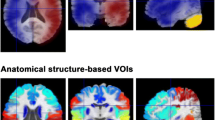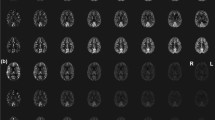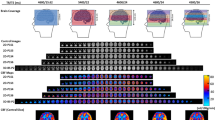Abstract
Perfusion-weighted imaging (PWI) by use of arterial spin labeling (ASL) has been introduced to the clinical setting. However, it is not widely available because it requires specialized pulse sequences. Imaging using a time-spatial labeling inversion pulse (time-SLIP), which is a magnetic resonance angiography (MRA) technique that is based on ASL, can be used in various situations. In this study, we examined the feasibility of time-SLIP PWI. Two types of time-SLIP sequences were evaluated: (1) a single inversion recovery (IR) pulse sequence, which is the same as that used in conventional time-SLIP MRA except for the timing of data acquisition, and (2) a dual IR pulse sequence, where a second, non-selective, IR pulse was added during the inflow time to suppress background signals. Subtraction processing is performed between the “on” and “off” settings of the first IR pulse (time-SLIP tag) to obtain PWI. The average signal intensity was measured in a uniform phantom as the residual of the background, and in five healthy subjects as the perfusion signal. The average signal-to-noise ratio (SNR) was also measured in the five subjects. All imaging was performed with a 1.5-T MR scanner. Images using the dual IR method showed lower background signals and higher perfusion signals compared with images using the single IR method. However, the SNR was lower in images with the dual IR method. These results demonstrate that a time-SLIP, which is an MRA method, can be used for obtaining cerebral PWI simply by adjusting the imaging parameters.








Similar content being viewed by others

References
Wolf RL, Detre JA. Clinical neuroimaging using arterial spin-labeled perfusion magnetic resonance imaging. Neurotherapeutics. 2007;4(3):346–59.
Tourdias T, Rodrigo S, Oppenheim C, Naggara O, Varlet P, Amoussa S, et al. Pulsed arterial spin labeling applications in brain tumors: practical review. J Neuroradiol. 2008;35(2):79–89.
Pollock JM, Tan H, Kraft RA, Whitlow CT, Burdette JH, Maldjian JA. Arterial spin-labeled MR perfusion imaging: clinical applications. Magn Reson Imaging Clin N Am. 2009;17(2):315–38.
Petcharunpaisan S, Ramalho J, Castillo M. Arterial spin labeling in neuroimaging. World J Radiol. 2010;2(10):384–98.
Deibler AR, Pollock JM, Kraft RA, Tan H, Burdette JH, Maldjian JA. Arterial spin-labeling in routine clinical practice, part 1: technique and artifacts. AJNR Am J Neuroradiol. 2008;29(7):1228–34.
Nishimura DG, Macovski A, Pauly JM, Conolly SM. MR angiography by selective inversion recovery. Magn Reson Med. 1987;4:193–202.
Edelman RR, Siewert B, Adamis M, Gaa J, Laub G, Wielopolski P. Signal targeting with alternating radiofrequency (STAR) sequences: application to MR angiography. Magn Reson Med. 1994;31:233–8.
Shimada K, Isoda H, Okada T, Maetani Y, Arizono S, Hirokawa Y, et al. Non-contrast-enhanced hepatic MR angiography with true steady-state free-precession and time spatial labeling inversion pulse: optimization of the technique and preliminary results. Eur J Radiol. 2009;70(1):111–7.
Shonai T, Takahashi T, Ikeguchi H, Miyazaki M, Amano K, Yui M. Improved arterial visibility using short-tau inversion-recovery (STIR) fat suppression in non-contrast-enhanced time-spatial labeling inversion pulse (time-SLIP) renal MR angiography (MRA). J Magn Reson Imaging. 2009;29(6):1471–7.
Satogami N, Okada T, Koyama T, Gotoh K, Kamae T, Togashi K. Visualization of external carotid artery and its branches: non-contrast-enhanced MR angiography using balanced steady-state free-precession sequence and a time-spatial labeling inversion pulse. J Magn Reson Imaging. 2009;30(3):678–83.
Hori M, Shiraga N, Watanabe Y, Aoki S, Isono S, Yui M, et al. Time-resolved three-dimensional magnetic resonance digital subtraction angiography without contrast material in the brain: initial investigation. J Magn Reson Imaging. 2009;30(1):214–8.
Miyazaki M, Lee VS. Nonenhanced MR angiography. Radiology. 2008;248(1):20–43.
Morita S, Masukawa A, Suzuki K, Hirata M, Kojima S, Ueno E. Unenhanced MR angiography: techniques and clinical applications in patients with chronic kidney disease. Radiographics. 2011;31(2):E13–33.
Garcia DM, Duhamel G, Alsop DC. Efficiency of inversion pulses for background suppressed arterial spin labeling. Magn Reson Med. 2005;54(2):366–72.
Calamante F. Perfusion MRI using dynamic-susceptibility contrast MRI: quantification issues in patient studies. Top Magn Reson Imaging. 2010;21(2):75–85.
Kuo PH, Kanal E, Abu-Alfa AK, Cowper SE. Gadolinium-based MR contrast agents and nephrogenic systemic fibrosis. Radiology. 2007;242(3):647–9.
Maleki N, Dai W, Alsop DC. Optimization of background suppression for arterial spin labeling perfusion imaging. MAGMA. 2012;25(2):127–33.
van Osch MJ, Teeuwisse WM, van Walderveen MA, Hendrikse J, Kies DA, van Buchem MA. Can arterial spin labeling detect white matter perfusion signal? Magn Reson Med. 2009;62(1):165–73.
Fernández-Seara MA, Edlow BL, Hoang A, Wang J, Feinberg DA, Detre JA. Minimizing acquisition time of arterial spin labeling at 3T. Magn Reson Med. 2008;59(6):1467–71.
Ye FQ, Frank JA, Weinberger DR, McLaughlin AC. Noise reduction in 3D perfusion imaging by attenuating the static signal in arterial spin tagging (ASSIST). Magn Reson Med. 2000;44(1):92–100.
Barbier EL, Lamalle L, Décorps M. Methodology of brain perfusion imaging. J Magn Reson Imaging. 2001;13(4):496–520.
Uchihashi Y, Hosoda K, Zimine I, Fujita A, Fujii M, Sugimura K, et al. Clinical application of arterial spin-labeling MR imaging in patients with carotid stenosis: quantitative comparative study with single-photon emission CT. AJNR Am J Neuroradiol. 2011;32(8):1545–51.
Yan L, Li C, Kilroy E, Wehrli FW, Wang DJ. Quantification of arterial cerebral blood volume using multiphase-balanced SSFP-based ASL. Magn Reson Med. 2012;68(1):130–9.
Acknowledgments
This work was supported in part by Grant-in-Aid for encouragement for Young Scientists from Ibaraki Prefectural University of Health Sciences.
Conflict of interest
The authors declare that they have no conflict of interest.
Author information
Authors and Affiliations
Corresponding author
About this article
Cite this article
Ishimori, Y., Kawamura, H. & Monma, M. Feasibility of MR perfusion-weighted imaging by use of a time-spatial labeling inversion pulse. Radiol Phys Technol 6, 461–466 (2013). https://doi.org/10.1007/s12194-013-0219-0
Received:
Revised:
Accepted:
Published:
Issue Date:
DOI: https://doi.org/10.1007/s12194-013-0219-0



